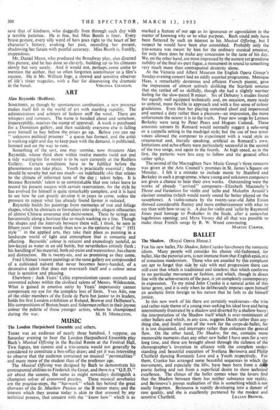BALLET The Shadow. (Royal Opera House.) FOR his new ballet,
The Shadow, John Cranko has chosen the romantic idiom. Many people will consider his choice old-fashioned, for ballet, like the pictorial arts, is not immune from that English epidt.mic of conscious modernism. Those who are assailed by this complaint are apt to forget that side by side with real progression there can still exist that which is traditional and timeless; that which conforms to no particular movement or fashion, and which, though indirect- line with the achievements of the past, is yet completely contemporary in expression. To my mind John Cranko is a natural artist of this latter genre, and it is only when he deliberately imposes upon himself an aesthetic form foreign to his nature that he fails to do himself justice.
In this new work of his there are certainly weaknesses—the trite and rather stale theme of a young man seeking his idepl love and being intermittently frustrated by a shadow and diverted by a shallow hussy; the interpretation of the Shadow itself which is over-reminiscent of other ballets and which, in any case, suggests Death rather than any- thing else, and finally most of the work for the corps-de-ballet, for it is too disjointed, and interrupts rather, than enhances the general flow. On the other hand, The Shadow, for me, contains more memorable moments than any other new ballet I have seen for a very long time, and these are brought about through the richness of the choreographer's invention in alliance with the complete under- standing and beautiful execution of Svetlana Beriosova and Philip Chatfield dancing Romantic Love and a Youth respectively. For them, Cranko has arranged some beautiful sequences in which the movements, and especially the lifts, have been born from a da poetic feeling and not from a superficial desire to show technical excellence. The climax of the ballet comes when the lovers find that the Shadow between them has neither substance nor reality, and Beriosova's joyous realisation of this is something which is not easily forgotten. Beriosova is rapidly developing into a dancer of rare quality, and she is excellently partnered by the modest and


































 Previous page
Previous page